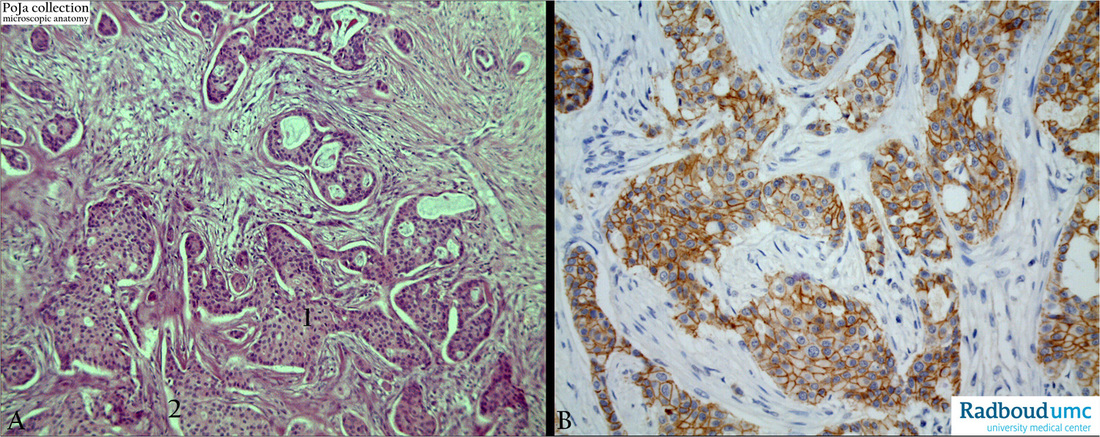7.4 POJA-L-4188+4189
Title: Positive E-cadherin for invasive ductal breast carcinoma, no special type (NST) (human)
Description: Stain: (A) Hematoxylin-eosin; (B) anti-cadherin antibody immunoperoxidase staining with diaminobenzidin reaction (DAB) and hematoxylin counterstaining;
(A): Low magnification of invasive ductal carcinoma-no special type. Malignant monophormic cells are disposed in solid cell nests with luminization (1) and anastomosing tubules. (2) Dense fibrous stroma.
(B): Anastomosing tubules of monophormic tumor cells show distinct linearly brown-stained membrane reactivity for E-cadherin. Stroma is negative.
(By courtesy of F. van de Molengraft MD PhD, Department of Pathology, Rijnstate Hospital, Arnhem, The Netherlands).
Background: Invasive ductal carcinoma NST (no special type) includes the majority of invasive breast carcinoma (over 50 % up to 80 %). Most of these neoplasms show an increase in dense fibrous tissue stroma (scirrhous carcinoma).
The E-cadherin membrane complex (E-cadherin, a, b, g-catenins and p120) is composed of transmembrane glycoproteins that mediates calcium-dependent cell-cell adhesion. It is mainly expressed in epithelial cells and plays an important role in epithelial differentiation and morphogenesis. In daily routine the application of the antibody to E-cadherin appears reliable for the discrimination between ductal and lobular carcinoma. Generally all in situ and invasive ductal carcinomas showed strong membrane E-cadherin expression in contrast to invasive lobular carcinomas (ILCs). However it should be noted that a proportion of morphologically typical ILCs retains its expression. It appears that in the majority of the cases one or more of the catenin-complex members are abnormal expressed, resulting in diffuse cytoplasmic expression of catenins (in particular p120). But its expression seems to be of limited significance and is usually associated with evidence of impaired integrity of the E-cadherin-catenin membrane complex (Rakha et al. 2010).
Keywords/Mesh: breast, mammary glands, breast neoplasms, ductal carcinoma, invasion, histology, POJA collection, cadherin,
Title: Positive E-cadherin for invasive ductal breast carcinoma, no special type (NST) (human)
Description: Stain: (A) Hematoxylin-eosin; (B) anti-cadherin antibody immunoperoxidase staining with diaminobenzidin reaction (DAB) and hematoxylin counterstaining;
(A): Low magnification of invasive ductal carcinoma-no special type. Malignant monophormic cells are disposed in solid cell nests with luminization (1) and anastomosing tubules. (2) Dense fibrous stroma.
(B): Anastomosing tubules of monophormic tumor cells show distinct linearly brown-stained membrane reactivity for E-cadherin. Stroma is negative.
(By courtesy of F. van de Molengraft MD PhD, Department of Pathology, Rijnstate Hospital, Arnhem, The Netherlands).
Background: Invasive ductal carcinoma NST (no special type) includes the majority of invasive breast carcinoma (over 50 % up to 80 %). Most of these neoplasms show an increase in dense fibrous tissue stroma (scirrhous carcinoma).
The E-cadherin membrane complex (E-cadherin, a, b, g-catenins and p120) is composed of transmembrane glycoproteins that mediates calcium-dependent cell-cell adhesion. It is mainly expressed in epithelial cells and plays an important role in epithelial differentiation and morphogenesis. In daily routine the application of the antibody to E-cadherin appears reliable for the discrimination between ductal and lobular carcinoma. Generally all in situ and invasive ductal carcinomas showed strong membrane E-cadherin expression in contrast to invasive lobular carcinomas (ILCs). However it should be noted that a proportion of morphologically typical ILCs retains its expression. It appears that in the majority of the cases one or more of the catenin-complex members are abnormal expressed, resulting in diffuse cytoplasmic expression of catenins (in particular p120). But its expression seems to be of limited significance and is usually associated with evidence of impaired integrity of the E-cadherin-catenin membrane complex (Rakha et al. 2010).
Keywords/Mesh: breast, mammary glands, breast neoplasms, ductal carcinoma, invasion, histology, POJA collection, cadherin,

